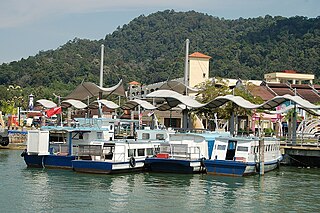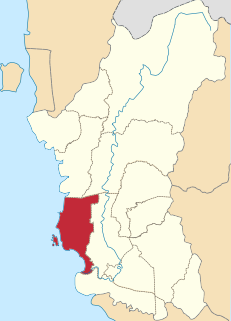
Perak is a state of Malaysia on the west coast of the Malay Peninsula. Perak has land borders with the Malaysian states of Kedah to the north, Penang to the northwest, Kelantan and Pahang to the east, and Selangor to the south. Thailand's Yala and Narathiwat provinces both lie to the northeast. Perak's capital city, Ipoh, was known historically for its tin-mining activities until the price of the metal dropped, severely affecting the state's economy. The royal capital remains Kuala Kangsar, where the palace of the Sultan of Perak is located. As of 2018, the state's population was 2,500,000. Perak has diverse tropical rainforests and an equatorial climate. The state's mountain ranges belong to the Titiwangsa Range, which is part of the larger Tenasserim Range connecting Thailand, Myanmar and Malaysia. Perak's Mount Korbu is the highest point of the range.

Sitiawan (alternate spelling: Setiawan; origin: from Malay, a portmanteau of SetiaKawan, meaning "Loyal Friend") is a region and town in Manjung District, Perak, Malaysia.

Lumut is a coastal town and mukim in Manjung District, Perak, Malaysia, situated about 84 km (52 mi) from Ipoh, 12 km (7.5 mi) from the town of Sitiawan and it is the main gateway to Pangkor Island before established Marina Island Pangkor as second gateway. It is noted for seashell and coral handicrafts. This once little-known fishing town has since become the home base of the Royal Malaysian Navy and the site of the biggest naval shipbuilder in Malaysia, Boustead.
Ayer Tawar is a small town of 30,000 people in Manjung District, Perak, Malaysia. Air Tawar literally means "fresh water" in the Malay language. The town is less well-known than its immediate and larger neighbour Sitiawan, which is 12 kilometres away.

The Manjung District is a district in the southwestern part of the state of Perak, Malaysia. The district is well known for its Pangkor Island, a major attraction in Perak and the home of the Royal Malaysian Navy (TLDM) Lumut Naval Base and dockyard. Since the population is increasing, residential and commercial infrastructure is being developed. Dinding was once part of the British Straits Settlements colony.
Pekan Gurney or Gurney's Town is a small town in Perak, Malaysia. The town was founded in 1952 and named after Sir Henry Gurney, a former British High Commissioner in Malaya
Seri Manjung is a town and district capital of Manjung District in Perak, Malaysia.The town was developed by State Government of Perak under Perbadanan Kemajuan Negeri Perak in the 1980s.It is located 7 km from Lumut and 70 km from the state capital, Ipoh. In the adjacent area, north of Seri Manjung is Sitiawan
The Anglo-Chinese School (ACS) Sitiawan, established in 1903 is the oldest and established primary and secondary educational institution located in Sitiawan. Although both shared the same name, the two schools are of separate entity as both have different management that handles both the ACS primary and ACS secondary school's matter.

The Royal Malaysia Police Museum is a museum that showcases the history of the Malaysia police force, located in Kuala Lumpur, Malaysia. The museum includes exhibits from the history of the Royal Malaysia Police since its origins under British colonial rule until the 1970s. It is open daily, except Monday, from 1000 to 1800 hours, and admission is free.

The Perak Museum is a public museum located at the junction of Jalan Muzium and Jalan Taming Sari in Taiping, Perak, Malaysia. It is the oldest museum in Malaysia and highlights the history of the state.

Sitiawan Airport is an airport in Sitiawan, Manjung, Perak, Malaysia.

Dato' Ngeh Koo Ham, also known as James Ngeh, is a Malaysian politician and lawyer. He is the current Member of Parliament (MP) for the seat of Beruas. Ngeh has also served as the Perak State Legislative Assemblyman for Sitiawan (2004-2018), Perak State Senior Executive Councillor (2008-2009) and Speaker of Perak State Assembly (2018-2020).

Zambry bin Abdul Kadir is a Malaysian politician who served as the 11th Menteri Besar of Perak from February 2009 to the collapse of the Barisan Nasional (BN) state administration in May 2018 and Member of the Perak State Executive Council (EXCO) in the BN state administration under former Menteri Besar Tajol Rosli Mohd Ghazali from March 2004 to another collapse of the BN state administration in March 2008. He has served as Member of the Perak State Legislative Assembly (MLA) for Pangkor since March 2004. He is a member of the United Malays National Organisation (UMNO), a component party of the federal ruling BN coalition which is aligned with another federal ruling Perikatan Nasional (PN) coalition at both the federal and state levels.

The Beruas Museum is a museum in Beruas, Manjung District, Perak, Malaysia.

Ong Seok Kim was an educationist, social worker, philanthropist and entrepreneur. He was born in Yongchun County, Southern Fujian Province in China and migrated to the then Malaya in 1903. As an entrepreneur, Ong began building up his wealth through trading in supplies for tin miners in the Ipoh/Gopeng area in the state of Perak, and later as a local trader in Sitiawan, Manjung District, also in Perak. He continued building his wealth through establishing retail shops, and later through investment in rubber estates and commercial properties in Manjung District and as far as Betong in Thailand. The wealth he created would later be used towards various charity and education projects in Manjung District, and in particular, Sitiawan town.

The Darul Ridzuan Museum is a museum in Ipoh, Kinta District, Perak, Malaysia.

Paul Yong Choo Kiong, is a Malaysian politician who has served as Member of the Perak State Legislative Assembly (MLA) for Tronoh since May 2013. He served as Member of the Perak State Executive Council (EXCO) in the Pakatan Harapan (PH) state administration under former Menteri Besar Ahmad Faizal Azumu from May 2018 to the collapse of the PH state administration in March 2020. He is currently a member of the Malaysian United Indigenous Party (BERSATU), a component party of the state ruling Perikatan Nasional (PN) coalition in the aftermath of 2020–21 Malaysian political crisis. Previously he was a member of the Democratic Action Party (DAP), a component party of the state PH opposition coalition.
Dabus is a warrior dance from the Malaysian state of Perak. This warrior dance, as such, is characteristically heroic, demanding performers to exhibits traits of intelligence, dexterity, heroism, and cheerfulness when performing. Dabus is one of the traditional dances of Perak that has survived some 300 years. There are conflicting theories on the origin of Dabus, with some historians claiming that it was brought over from Aceh, while other historians believe it to have been brought over from Baghdad during the 18th century.













